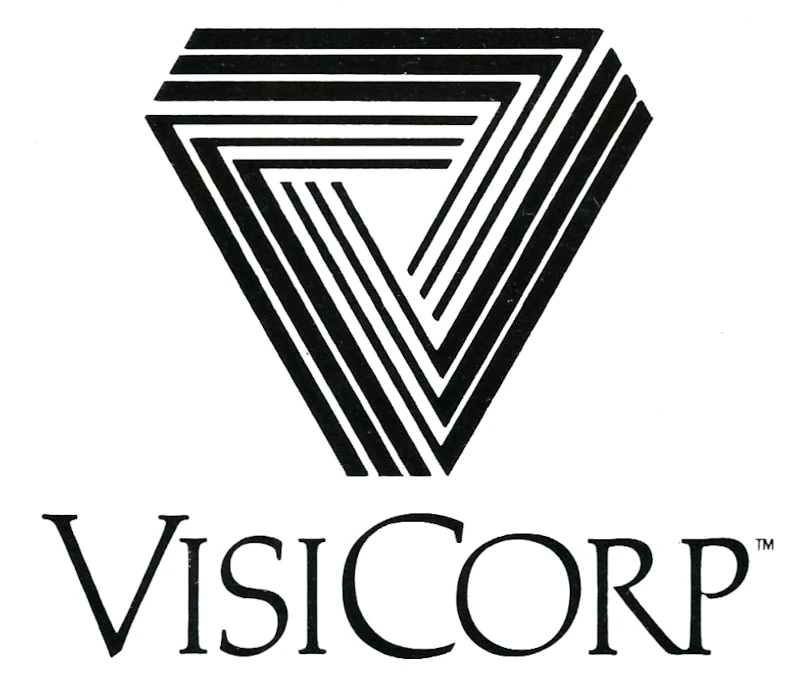
VisiCorp Advert - May 1982
From Personal Computing
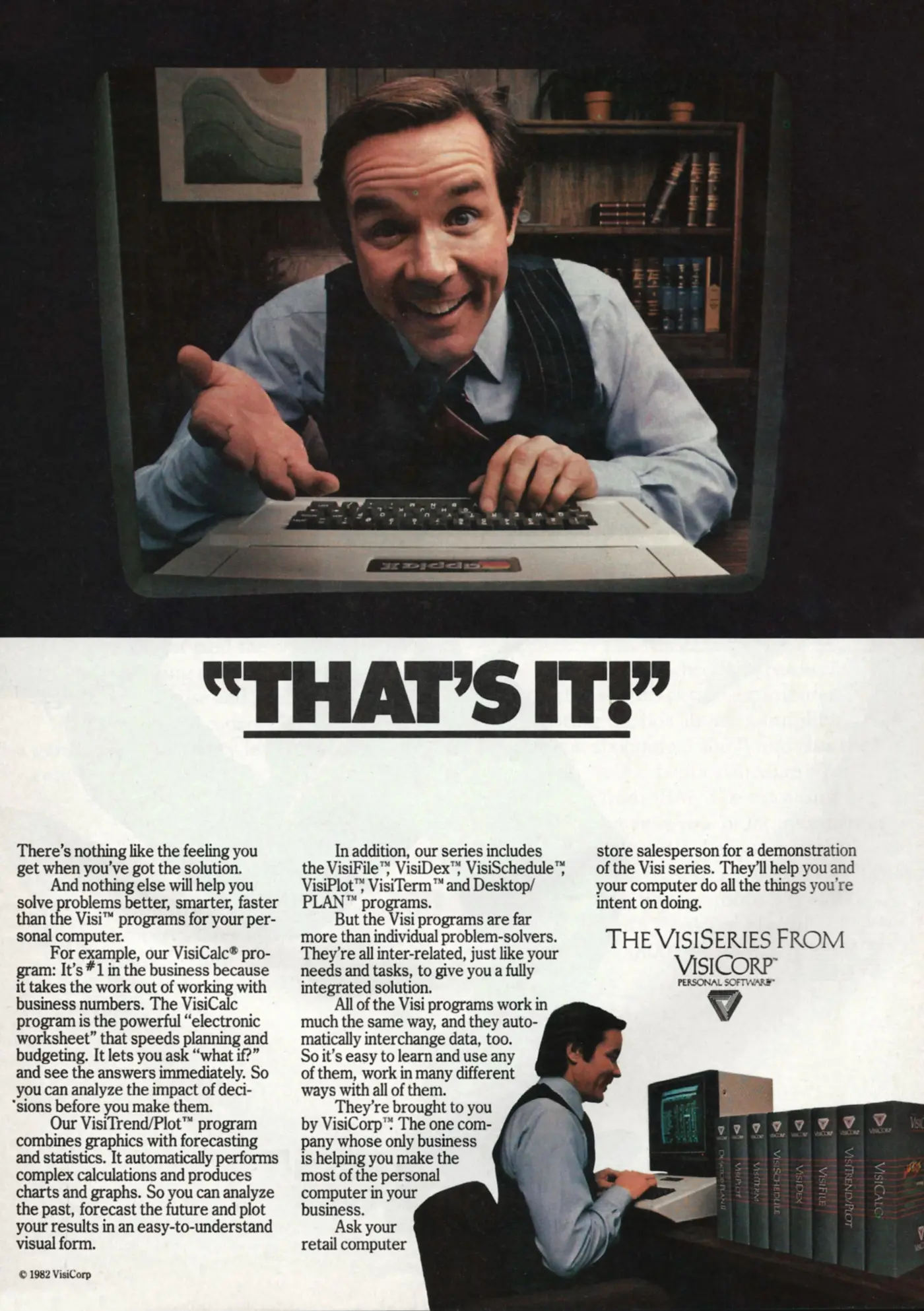
That's it! The VisiSeries from VisiCorp
Any history of the early microcomputer industry would not be complete without a mention of VisiCalc - the first ever "killer app".
Not only did VisiCalc create an entirely new category of software, but it even inadvertently saved Apple in the process.
VisiCorp - the company - had been founded by Dan Fylstra in the autumn of 1978 as Personal Software.
Fylstra already had a long (for the time) association with the micro industry as in 1975 he became the founding Associate Editor of Byte magazine, which probably meant he got discounted rates when Personal Software started advertising in Byte towards the end of 1978.
One of the products in Personal Software's early adverts was the 50,000-selling MicroChess, written by Peter Jennings originally for the MOS/Commodore KIM-1. Jennings would become Fylstra's business parter[1] after Jennings' company Micro-Ware merged with Personal Software.
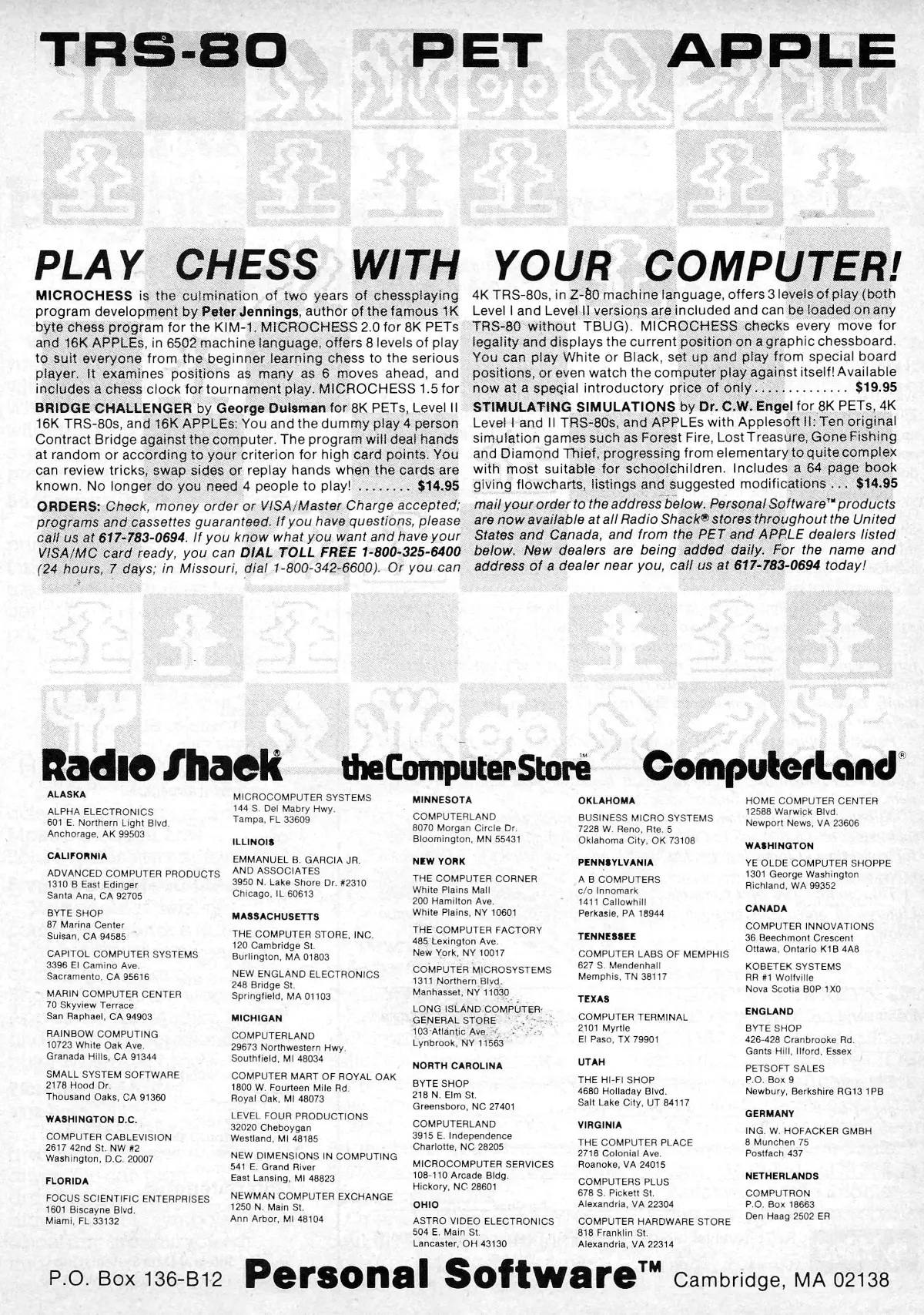
A Personal Software advert, including Microchess by Peter Jennings . From Byte, December 1978
Meanwhile, back in the spring of 1978, Harvard Business School student Dan Bricklin had been daydreaming about a calculator with a mouse-ball in its back which could be used to "move around, punch in a few numbers [and] circle them to get a sum".
In the summer of 1978 whilst on his bike cycling around Martha's Vineyard, Bricklin decided to pursue the idea more seriously. Both Bricklin and Fylstra shared a tutor in Charles Kelso, a professor of finance, who put the two in touch with each other after Bricklin had gone to him for advice.
Fylstra was sufficiently intrigued by Bricklin's ideas that he invited him over the Personal Software's "office" - his apartment in Allston, Massachussets.
Bricklin had originally intended to write his "electronic blackboard" for the DEC PDT - a smart terminal which was built around the LSI-11 processor[2], which was essentially an entire DEC PDP-11 on a single chip.
Bricklin was familiar with these after having worked at DEC on a word-processing application, and was unsure about whether the latest microcomputers would run his application.
Fylstra however had the complete 1977 Trinity - the Commodore PET, RadioShack TRS-80 and Apple II - in his office, and ended up "enthusiastically arguing" for the personal computer as the "platform for the future".
Fylstra had previously programmed on the 6502, as found on both the PET and the Apple, but he particularly liked Apple's "marketing strategy and prowess" and also saw an opportunity to work with Apple reseller Computerland, and so the Apple II was chosen.
Fylstra lent Personal Software's own Apple II - purchased directly from Steve Jobs - to Bricklin so he could actually develop his spreadsheet ideas[3].
Bricklin, along with MIT classmate Bob Frankston - who had been writing freelance software for machines like ECD's Micromind - were soon invited to work for Personal Software, but Bricklin declined, stating that he wanted to start his own company.
Instead, the two formed Software Arts Incorporated, with Personal Software acting as publisher, and the two programmers working in Frankston's attic.
VisiCalc rapidly became the first "killer app" after its release at the end of 1979, which meant that buyers were now seeking out the machine that could run it, rather than the other way around.
Apple's success in this area was cemented by its exclusive licence for VisiCalc for its first year of production, a move which helped the company go from revenues of $800,000 in 1977 to nearly $48 million in 1979[4].
Meanwhile, relations between Personal Software and Software Arts started deteriorating when the former moved across the country in mid 1979 to Sunnyvale in California, so that it could be closer to where most of the microcomputer action was.
The two companies were also expanding, with new people joining and separate cultures developing, and in an echo of the music industry - where the lead singer often becomes "the band" - VisiCalc was increasingly becoming associated with Fylstra and Personal Software, rather than Bricklin and Frankston.
To try and patch things up, the two companies considered a merger, but in the meantime both of them hired new presidents, with Personal Software hiring Terry Opdendyk from Intel. Opdendyk considered a merger as unneccesary, and it appeared that the two presidents didn't exactly get on, so the idea was canned.
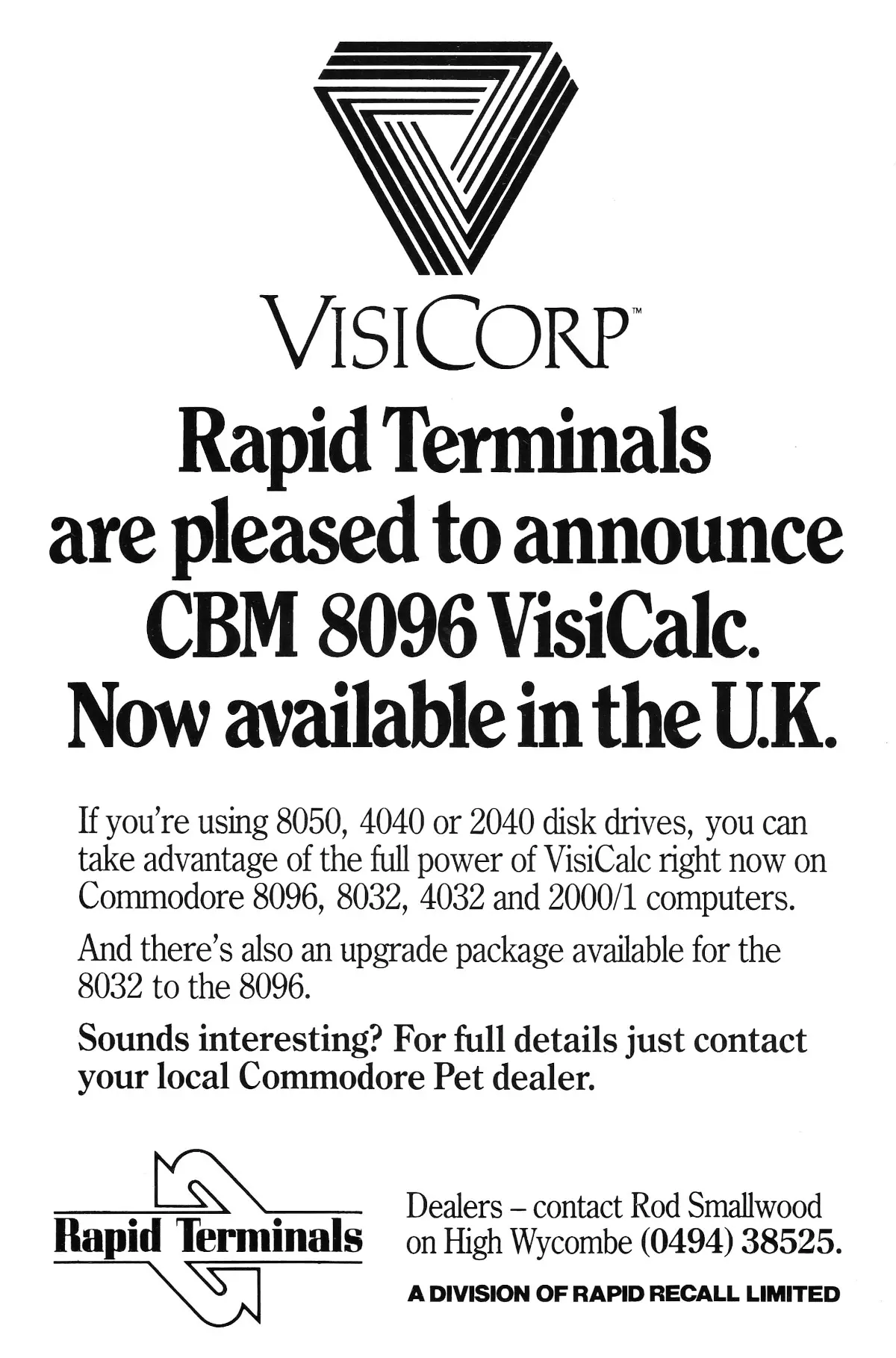
VisiCalc makes it to the UK on the Commodore/CBM range of micros. From Commodore Computing International, November 1982
VisiCalc was eventually ported to other microcomputers, starting with the Commodore PET and the Atari 800, as these were also 6502-based and so were relatively easy to convert to. VisiCalc had been written in processor-specific assembly language, so porting to CP/M machines based on Intel's 8080 or Zilog's Z80 meant essentially a complete re-write.
Software Arts took a while to get round to this, which meant it missed out on shipping with Adam Osborne's Osborne 1 - the influential and briefly-successful luggable microcomputer launched at the West Coast Computer Faire in 1981, and which became famous for its bundled software. Instead, Osborne went with Sorcim's SuperCalc - a CP/M-based VisiCalc clone.
By the time of the advert, Personal Software was also publishing other programs under the "Visi" brand, including VisiFile, VisiDex, VisiSchedule, VisiPlot and VisiTerm.
Personal Software ended up changing its name to VisiCorp in early 1982 to reflect this brand identity - the main advert even appears to show this with the tagline "The VisiSeries from VisiCorp. Personal Software".
VisiPlot had been written by Mitch Kapor, who after working for VisiCorp as the VisiCalc product manager, would leave to start Lotus, which ended up eating the spreadsheet market with its 1-2-3 program.
It wasn't just Lotus that was ramping up the competition, as Microsoft was also entering the fray with its Multiplan spreadsheet, introduced in 1982. Software Arts didn't seem to be keen on updating VisiCalc with new features, which became yet another source of discontent within the partnership.
Meanwhile, the original agreement between the two companies - based partly upon book-publishing contracts - was coming under pressure.
Even though Bricklin's "electronic blackboard" - known early on as Calcu-ledger, but by now known as VisiCalc - was generating royalty rates of 35.7%, which was very high for a publishing deal, Software Arts, Inc., was becoming increasingly unhappy with the arrangement. Rumours suggested that it was looking for 50% for its next product - TK!Solver.
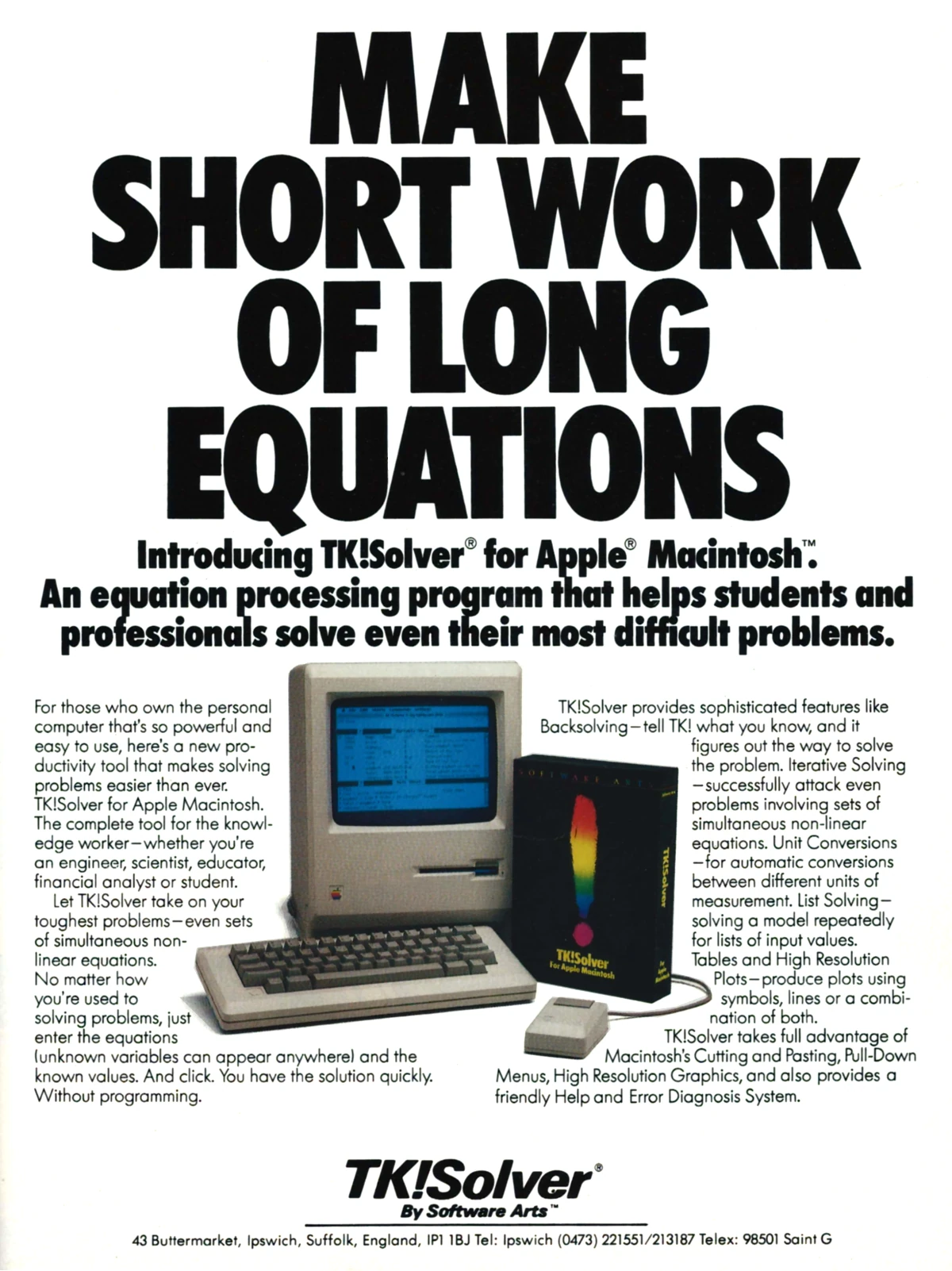
An advert for Software Arts' TK! Solver, from Personal Computer World, March 1985. The address is given as 43 Buttermarket, Ipswich, which is a shopping mall in the middle of the town.
Things came to a head at a time when VisiCorp had spent $10 million and several years' development on its next big thing - the VisiOn graphical interface, which - like Apple's later OS for the Macintosh - was largely inspired by Xerox PARC's work.
The company then apparently got word that Software Arts was going to sue in order to block the shipping of VisiOn, so its attorneys suggested getting in first with a counter-suit, which it did in 1983[5].
In Dan Bricklin's account of events, the lawsuit came from VisiCorp completely unexpectedly. So exactly who fired the first shot in the lawsuit is contested, but the end result of the settlement, which was reached in 1984, was VisiCorp losing the VisiCalc trademark, although it got to keep the "Visi" name which it had become somewhat dependent upon.
Eventually, both VisiCorp and Software Arts were sold, with the latter going to Lotus. Lotus stopped shipping VisiCalc in 1985.
Lotus's own 1-2-3 - which was actually an application suite and not just a spreadsheet - nevertheless came to dominate the spreadsheet market for a couple of years after its launch in 1983.
Lotus's domination was no doubt helped when Software Arts launched a direct-sales campaign, effectively taking VisiCalc out of the dealer network where its sales were actually made. It turned out that people didn't actually want to buy spreadsheets via mail order after all.
None of it really mattered in the end though as Microsoft's Excel - launched in 1985 - bulldozed everything in its path, along with the rise of Windows.
---
If ifs and ands were pots and pans...
It's interesting to speculate just how different things could have gone at this point in the history of microcomputers.
The Apple II wasn't chosen to develop VisiCalc on for any particular reason other than the fact the Dan Fylstra liked the company's marketing, it used a 6502 processor, and it had a memory-mapped display, which was needed in order for VisiCalc to be able to update its display fast enough.
However, the Commodore PET also had a 6502 and memory-mapping, and Peter Jennings - the other partner in Personal Software - had a long history with Commodore, having developed his highly-successful MicroChess for the KIM-1 back in 1976.
If Fylstra had been busy, or had been called away, when Dan Bricklin came to visit, and Jennings had met him instead, Jennings might have swung the target for VisiCalc in favour of the PET. Apple - which was struggling financially at the time - would not have got the "killer app" to save it and it may have gone bust. An entire line of products from the Macintosh through to the iPod and iPhone would not have existed.
The PET would have become the machine everyone wanted, pushing its sales through the roof, and the success of it might have meant that Commodore would not have become interested in the home computer market. It would not have released the VIC-20 and then the Commodore 64, so some other company - maybe Atari - would have owned the home-computer market in the US.
Jack Tramiel may still have left Commodore, but there wouldn't have been a bankrupt Atari available for sale, so there wouldn't have been an Atari ST.
Commodore's success with the PET line would have meant it wouldn't have needed to go looking for a new way to get into the business market, so it wouldn't have bought Hi-Toro and so there wouldn't have been an Amiga either.
IBM would probably have still released the 5150 PC, but a stronger Commodore might have been able to fend it off with something more radical. Perhaps the company might even still be around today, like Apple is in the actual world.
Date created: 04 March 2024
Last updated: 11 December 2024
Hint: use left and right cursor keys to navigate between adverts.
Sources
Text and otherwise-uncredited photos © nosher.net 2025. Dollar/GBP conversions, where used, assume $1.50 to £1. "Now" prices are calculated dynamically using average RPI per year.